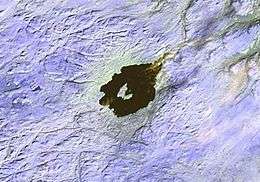Mistastin crater
 | |
| Impact crater/structure | |
|---|---|
| Confidence | Confirmed[1] |
| Diameter | 19 kilometres (12 mi) |
| Age | 36.4 ± 4 million years old (Eocene Epoch) |
| Exposed | Yes |
| Drilled | Yes |
| Location | |
| Location | Labrador, Newfoundland and Labrador, Canada |
| Coordinates | 55°53′N 63°18′W / 55.883°N 63.300°WCoordinates: 55°53′N 63°18′W / 55.883°N 63.300°W |
 Mistastin crater Location of the Mistastin crater in Labrador | |
| Topo map | Canada NTS 13M |
| Mistastin Lake | |
|---|---|
| Coordinates | 55°53′N 63°18′W / 55.883°N 63.300°W |
| Type | impact crater lake |
| Basin countries | Canada |
| Max. length | 19 km (12 mi) |
| Max. width | 12 km (7.5 mi) |
| Surface area | 145 km2 (56 sq mi) |
| Surface elevation | 338 metres (1,109 ft) |
| Islands | Horseshoe Island |
Mistastin crater is a meteorite crater in Labrador, Canada which contains the roughly circular Mistastin Lake.[2] The lake is approximately 16 km (9.9 mi) in diameter, while the estimated diameter of the original crater is 28 km (17 mi). The age of the crater is calculated to be 36.4 ± 4 million years (Eocene).
Formation and geology
Mistastin crater was created 36 million years ago by a violent asteroid impact.[3] The presence of cubic zirconia around the crater rim suggests that the impact generated temperatures in excess of 2,370 °C (4,300 °F) (halfway that of the surface of the Sun), the highest crustal temperatures known on Earth[3] and produced global changes that lasted for decades after the impact.
The lake's arcuate central island is interpreted to be the central uplift of the complex crater structure. The target rocks were part of a batholith composed of adamellite, mangerite and lenses of anorthosite. There are abundant shock metamorphic features exhibited in the rocks of the island. Planar deformation features, diaplectic glass, melt rocks, and shatter cones have been identified.
References
- ↑ "Mistastin". Earth Impact Database. University of New Brunswick. Retrieved 2009-08-19.
- ↑ "Mistastin". Earth Impact Database. University of New Brunswick. Retrieved 2007-01-13.
- 1 2 Dvorsky, George (2017-09-17). "The Hottest Known Temperature On Earth Was Caused By An Ancient Asteroid Strike". Gizmodo. Retrieved 2017-09-17.
Further reading
- Currie, K.L. (1968) "Mistastin Lake, Labrador: A new Canadian crater". Nature, v. 220, pp. 776–777.
- Currie, K.L. Larochelle, A. (1969) "A paleomagnetic study of volcanic rocks from Mistastin Lake, Labrador, Canada". Earth and Planetary Science Letters, v. 6, pp. 309–315.
- Currie, K.L. (1971) "Geology of the resurgent cryptoexplosion crater at Mistastin Lake, Labrador". Geological Survey of Canada Bulletin 207, 62 p.
- Currie, K.L. (1971) "The composition of anomalous plagioclase glass and coexisting plagioclase from Mistastin Lake, Labrador, Canada". Mineralogical Magazine, v. 38, pp. 511–517.
- Grieve, R.A.F. (1975) "Petrology and chemistry of the impact melt at Mistastin Lake crater, Labrador". Geological Society of America Bulletin 86, pp. 1617–1629.
- Mak, E.K.C. York, D., Grieve, R.A.F. and Dence, M.R. (1976) "The age of the Mistastin Lake crater, Labrador, Canada". Earth and Planetary Science Letters, v. 31, pp. 345–357.
- Marchand, M. Crocket, J.H. (1977) "Sr isotopes and trace element geochemistry of the impact melt and target rocks at the Mistastin Lake crater, Labrador". Geochimica et Cosmochimica Acta, v. 41, pp. 1487–1495.
External links

